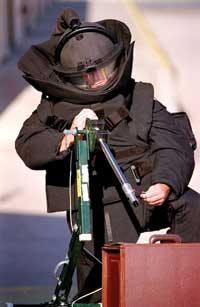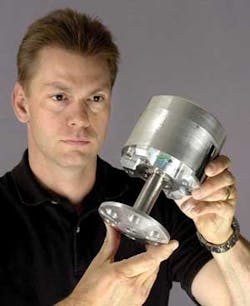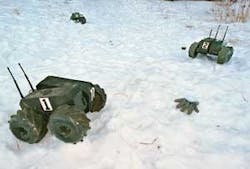By Ben Ames
KIRTLAND AIR FORCE BASE, N.M. - Industrial robots can operate with great precision in controlled environments, such as building cars in a factory. They face a greater challenge, however, when they confront the outside environment where vibration shakes their tools, and weather blocks their sensors.
Now researchers at Sandia National Laboratories in Albuquerque, N.M., are building systems that combine the strengths of humans and robots.
Sandia researchers improve the human-robot interface for jobs like defusing briefcase bombs.
“At the FBI hazardous devices school it takes two weeks to learn to drive a bomb squad robot, but an untrained operator can beat that performance after just 15 minutes of training with our method,” says Ray Harrigan, a robotics expert with Sandia’s Intelligent Systems and Robotics Center (ISRC).
Using conventional controls, a driver steers a robot by watching a video feed and moving a joystick. Most people find this method awkward since wireless links delay their reactions, and the video gives a limited scope of view.
That is one reason NASA controllers can drive the Mars Rovers just 12 inches per day; they face a 20-minute delay in sending controls, and no chance to right the robot if it tips over.
In Sandia’s new approach, the robot has much more independence. It asks for help from its driver only for the most “human” skills, such as distinguishing between an object and its shadow, or locating the hinge of a briefcase.
Humans make these intuitive judgments almost instantly, while a robot could take hours to reach the same conclusion methodically, Harrigan says.
“Common sense is involved in the simplest jobs,” he says. “If we send the robot out to place a sensor; it doesn’t even need to articulate anything but it must know how to place the unit right-side up.”
Using the new method, a robot could drive near a suspicious briefcase automatically, and use sensors to test the handle and seams for explosive residue. Lacking common sense, however, a robot needs help to locate those parts.
To this end, a human controller sitting in a remote truck or trailer can use a pen to circle the briefcase handle and four corners on a touch-screen display. With those parameters, the robot can interpolate the dimensions of the briefcase and return to autonomous operation. It can test the suitcase, x-ray it, then use a shotgun or water cannon to cut the triggering circuit before it detonates.
Sandia researchers test the system by inviting local Albuquerque police officers to experiment with the robots at their Robotic Vehicle Range.
The range is a 226-acre plot near the Manzano Mountains, off the pavement of Sandia’s gleaming 21st-century campus, and over rutted dirt roads near a landfill.
This is clearly an engineer’s playground: a road sign reads “Gravity, inertia, and big trucks ahead.” The robots are named SandDragon, Gemini, Atlas, and RATLER.
The common thread in these robots is their use of new technology to operate in unpredictable environments like city streets and battlefields.
“For industrial applications you’re looking at a situation where a robot is bolted to the floor and people bring things to it, but this has to drive out into the boonies and pick out what’s important to it,” he says.
“This is much smaller than what’s in the lab. Lower weight gives less structural rigidity. These things shake, so precision movement is not in the cards.”
One way they cope with rough environments is to use cameras and other sensors to triangulate the images to create three-dimensional pictures.
The method works better than obeying a driver with a teleoperated control box, yet robots need help to calibrate the images; a human must show the robot where images overlap, indicating landmarks that appear in both pictures.
Some Sandia robots can travel over rubble and rough ground by jumping like grasshoppers.
Even with 3-D cameras, robots cannot drive over rubble, so Sandia researchers are experimenting with one called Gemini. With several units linked together, it looks like a train; as the front units pull and the rear ones push. With four or five such units linked together, the Gemini can scale a five-foot wall, Harrigan says.
Another way to clear a rubble pile is to jump over it.
Sandia engineers have built baseball-sized microbots that can hop through the air, and then jump again even if they land upside-down. Those robots operate as swarms to establish networks to achieve their goals as a group. For more information, see www.sandia.gov/isrc/Roboticvehicles.html.
One of Sandia’s most important tools in building interfaces between humans and robots is Red Storm, in which researchers use the supercomputer to model the most complex part of that equation - human actions.
Red Storm is a $90 million, 41.5 teraflops (trillion operations/second) air-cooled supercomputer built mostly with COTS parts from Cray Inc. At full power, it will use 300 cabinets holding 96 processors each, for a total of 30,000 processors.
Swarms of small robots from Sandia communicate in a network to achieve tasks like finding buried avalanche victims.
Not all military robots venture onto battlefields. Sandia researchers also build robots to monitor nuclear weapon cores and to disassemble land mines. For either job, the goal is to remove people from hazardous or tedious tasks.
One of these robots has been operating at the Pantex Plant near Amarillo, Texas, since 2001, where technicians monitor plutonium pits from decommissioned nuclear weapons. To avoid radiation leaks, they periodically remove the pits from insulated barrels. Human workers accumulate radiation doses as they do this work, so Pantex began using a robot to do the work.
The exact core dimensions are classified, so Sandia workers designed their robot to work with a common mockup - a bowling ball. They built it with a GMF Robotics S-700 robotic arm fitted with specialized software and sensor systems that rely on feedback from vision and force sensors, says Sandia technician William Drotning.
Sandia researchers are also designing a robot to disassemble land mines at McAlester Army Ammunition Plant, Oklahoma.
Workers there take apart munitions containing 36 land mines stacked in each projectile. Each mine is designed to jump six feet in the air and explode, making this a dangerous job. The new Sandia robot can disassemble each projectile in nine minutes, with three projectiles on the conveyor at a time. Technicians planned to ship the first one to Oklahoma in October.



